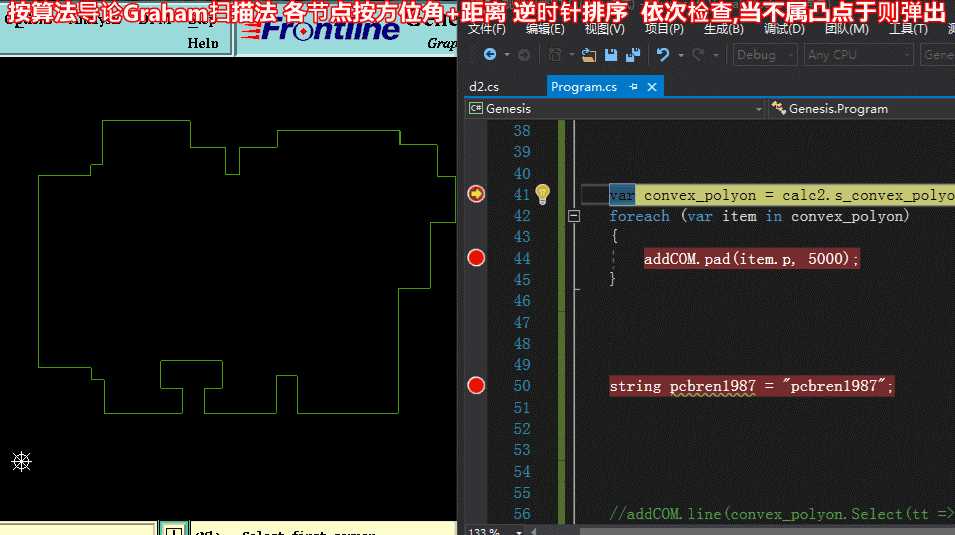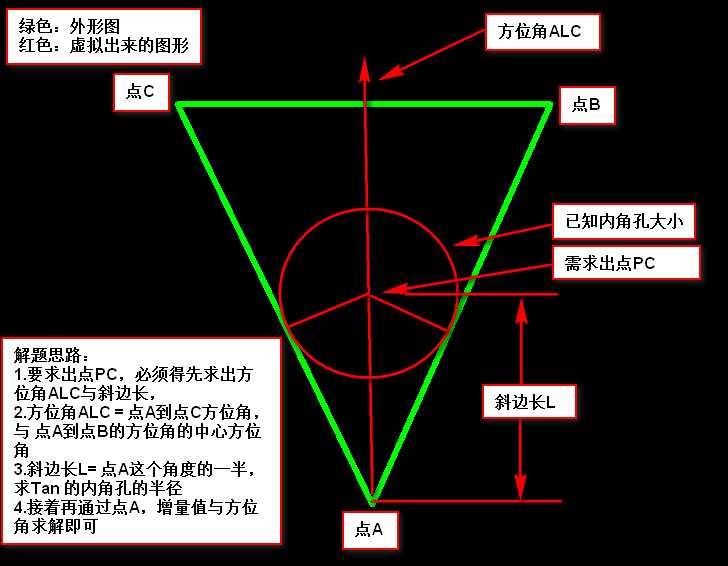PCB 板边倒圆角的实现方法(基本算法一)
Posted pcbren
tags:
篇首语:本文由小常识网(cha138.com)小编为大家整理,主要介绍了PCB 板边倒圆角的实现方法(基本算法一)相关的知识,希望对你有一定的参考价值。
当PCB外形是直角时,通常工程制作外形(锣带)时,会将直角或尖角的地方倒成圆角,主要是为了防止板边容易划伤板且容易扎伤人
所以当客户没有特殊要求时,PCB外形是直角一般会默认倒角0.5mm圆角(如下图所示)

原PCB外形 如下图图示:看了这个PCB外形,产生有2个问题点.
1.外形中哪些点需倒圆角?
2.如何怎么倒圆角?

1.外形中哪些点需倒圆角?
看下图: PCB外形倒圆角的点,刚好就是我们凸包需求出的点,接下来我们将玩转凸包了,只要求出凸包,那么就可以实现PCB板边倒圆角啦。

求凸包的算法:我们可以借鉴算法导论中的查找凸包的算法(加以改进得到新的求凸包方法,详见【方法一】与【方法二】)

2.如何怎么倒圆角?
在下面有说明倒角方法.
方法一求凸点:【采用多轮遍历,一遍一遍将凹点踢除,剩于的即是凸点】

方法一求凸点: 代码
/// <summary> /// 求最大多边形最大凸包1 【采用多轮遍历将凹点踢除,剩于的即是凸点】 /// </summary> /// <param name="gSur_Point_list"></param> /// <returns></returns> public List<gSur_Point> s_convex_polyon1(List<gSur_Point> gSur_Point_list) add addCOM = new add(); bool isOK = true; List<gSur_Point> PointList = new List<gSur_Point>(); var isCCW = s_isCCW(gSur_Point_list); int sum = gSur_Point_list.Count() - 1; int n = gSur_Point_list.Count(); for (int i = 0; i < n; i++) int IndexPre = (i - 1) % sum; if (IndexPre == -1) IndexPre = sum - 1; int IndexCurrent = i % sum; int IndexNext = (i + 1) % sum; if (gSur_Point_list[IndexPre].type_point > 0) continue; if (gSur_Point_list[IndexCurrent].type_point > 0) continue; var multiVal = multi(gSur_Point_list[IndexPre].p, gSur_Point_list[IndexCurrent].p, gSur_Point_list[IndexNext].p); if ((isCCW && multiVal > 0) || (!isCCW && multiVal < 0)) PointList.Add(gSur_Point_list[IndexCurrent]); else isOK = false; List<gSur_Point> Point2List = new List<gSur_Point>(PointList); while (!isOK) isOK = true; PointList.Clear(); PointList.AddRange(Point2List); Point2List.Clear(); sum = PointList.Count() - 1; n = PointList.Count(); for (int i = 0; i < n; i++) int IndexPre = (i - 1) % sum; if (IndexPre == -1) IndexPre = sum - 1; int IndexCurrent = i % sum; int IndexNext = (i + 1) % sum; var multiVal = multi(PointList[IndexPre].p, PointList[IndexCurrent].p, PointList[IndexNext].p); if ((isCCW && multiVal > 0) || (!isCCW && multiVal < 0)) Point2List.Add(PointList[IndexCurrent]); else isOK = false; return Point2List;
方法二求凸包:【采用一边遍历找出凸点并加入队列,并同时将队列中的凸点队列中找出凹点踢除】

方法二求凸包代码:
/// <summary> /// 求最大多边形最大凸包2 【采用一边遍历找出凸点并加入队列,并同时将队列中的凸点队列中找出凹点踢除】 /// </summary> /// <param name="gSur_Point_list"></param> /// <returns></returns> public List<gSur_Point> s_convex_polyon2(List<gSur_Point> gSur_Point_list) Stack<gSur_Point> StackPoint = new Stack<gSur_Point>(); var isCCW = s_isCCW(gSur_Point_list); int sum = gSur_Point_list.Count() - 1; int n = gSur_Point_list.Count(); for (int i = 0; i < n; i++) int IndexPre = (i - 1) % sum; if (IndexPre == -1) IndexPre = sum - 1; int IndexCurrent = i % sum; int IndexNext = (i + 1) % sum; if (gSur_Point_list[IndexPre].type_point > 0) continue; if (gSur_Point_list[IndexCurrent].type_point > 0) continue; var multiVal = multi(gSur_Point_list[IndexPre].p, gSur_Point_list[IndexCurrent].p, gSur_Point_list[IndexNext].p); if ((isCCW && multiVal > 0) || (!isCCW && multiVal < 0)) L1: if (StackPoint.Count > 1) var Top1Point = StackPoint.Pop(); var Top2Point = StackPoint.Peek(); multiVal = multi(Top2Point.p, Top1Point.p, gSur_Point_list[IndexCurrent].p); if ((isCCW && multiVal > 0) || (!isCCW && multiVal < 0)) StackPoint.Push(Top1Point); else goto L1; StackPoint.Push(gSur_Point_list[IndexCurrent]); return StackPoint.Reverse().ToList();
方法三求凸包:【按算法导论Graham扫描法 各节点按方位角+距离 逆时针排序 依次检查,当不属凸点于则弹出】

方法三求凸包代码
/// <summary> /// 求最大多边形最大凸包5 【按算法导论Graham扫描法 各节点按方位角+距离 逆时针排序 依次检查,当不属凸点于则弹出】 /// 由于把各点的排列顺序重新排序了,只支持折线节点(当存在弧节点时会出异常 !!!) /// </summary> /// <param name="gSur_Point_list"></param> /// <returns></returns> public List<gSur_Point> s_convex_polyon3(List<gSur_Point> gSur_Point_list) var LeftBottomPoint = gSur_Point_list.OrderBy(tt => tt.p.y).ThenBy(tt => tt.p.x).FirstOrDefault(); gSur_Point_list.RemoveAt(gSur_Point_list.Count - 1); gSur_Point_list.ForEach(tt => tt.Value = p2p_di(LeftBottomPoint.p, tt.p); tt.Angle = p_ang(LeftBottomPoint.p, tt.p); ); gSur_Point_list = gSur_Point_list.OrderBy(tt => tt.Angle).ThenBy(tt => tt.Value).ToList(); gSur_Point_list.Add(gSur_Point_list[0]); Stack<gSur_Point> StackPoint = new Stack<gSur_Point>(); var isCCW = true; int sum = gSur_Point_list.Count() - 1; int n = gSur_Point_list.Count(); for (int i = 0; i < n; i++) int IndexPre = (i - 1) % sum; if (IndexPre == -1) IndexPre = sum - 1; int IndexCurrent = i % sum; int IndexNext = (i + 1) % sum; var multiVal = multi(gSur_Point_list[IndexPre].p, gSur_Point_list[IndexCurrent].p, gSur_Point_list[IndexNext].p); if (isCCW && multiVal > 0) L1: if (StackPoint.Count > 1) var Top1Point = StackPoint.Pop(); var Top2Point = StackPoint.Peek(); multiVal = multi(Top2Point.p, Top1Point.p, gSur_Point_list[IndexCurrent].p); if (isCCW && multiVal > 0) StackPoint.Push(Top1Point); else goto L1; StackPoint.Push(gSur_Point_list[IndexCurrent]); return StackPoint.Reverse().ToList();
公共方法与数据结构

/// <summary> /// Surface 坐标泛型集类1 /// </summary> public class gSur_Point public gSur_Point() public gSur_Point(double x_val, double y_val, byte type_point_) this.p.x = x_val; this.p.y = y_val; this.type_point = type_point_; public gSur_Point(gPoint p, byte type_point_) this.p = p; this.type_point = type_point_; public gPoint p; /// <summary> /// 0为折点 1为顺时针 2为逆时针 /// </summary> public byte type_point get; set; = 0; /// <summary> /// 值 /// </summary> public double Value get; set; = 0; /// <summary> /// 角度 /// </summary> public double Angle get; set; = 0; /// <summary> /// 标记 /// </summary> public bool isFalg get; set; /// <summary> /// 点 数据类型 (XY) /// </summary> public struct gPoint public gPoint(gPoint p_) this.x = p_.x; this.y = p_.y; public gPoint(double x_val, double y_val) this.x = x_val; this.y = y_val; public double x; public double y; public static gPoint operator +(gPoint p1, gPoint p2) p1.x += p2.x; p1.y += p2.y; return p1; public static gPoint operator -(gPoint p1, gPoint p2) p1.x -= p2.x; p1.y -= p2.y; return p1; public static gPoint operator +(gPoint p1, double val) p1.x += val; p1.y += val; return p1; public static bool operator ==(gPoint p1, gPoint p2) return (p1.x == p2.x && p1.y == p2.y); public static bool operator !=(gPoint p1, gPoint p2) return !(p1.x == p2.x && p1.y == p2.y); /// <summary> /// 求叉积 判断【点P与线L】位置关系【小于0】在右边 【大于0】在左边 【等于0】共线 /// </summary> /// <param name="ps"></param> /// <param name="pe"></param> /// <param name="p"></param> /// <returns>【小于0】在右边 【大于0】在左边 【等于0】共线</returns> public double multi(gPoint ps, gPoint pe, gPoint p) return ((ps.x - p.x) * (pe.y - p.y) - (pe.x - p.x) * (ps.y - p.y)); /// <summary> /// 检测 Surface是否逆时针 /// </summary> /// <param name="gSur_Point_list"></param> /// <returns></returns> public bool s_isCCW(List<gSur_Point> gSur_Point_list) double d = 0; int n = gSur_Point_list.Count() - 1; for (int i = 0; i < n; i++) if (gSur_Point_list[i].type_point > 0) continue; int NextI = i + 1 + (gSur_Point_list[i + 1].type_point > 0 ? 1 : 0); d += -0.5 * (gSur_Point_list[NextI].p.y + gSur_Point_list[i].p.y) * (gSur_Point_list[NextI].p.x - gSur_Point_list[i].p.x); return d > 0; /// <summary> /// 返回两点之间欧氏距离 /// </summary> /// <param name="p1"></param> /// <param name="p2"></param> /// <returns></returns> public double p2p_di(gPoint p1, gPoint p2) return Math.Sqrt((p1.x - p2.x) * (p1.x - p2.x) + (p1.y - p2.y) * (p1.y - p2.y)); /// <summary> /// 求方位角 /// </summary> /// <param name="ps"></param> /// <param name="pe"></param> /// <returns></returns> public double p_ang(gPoint ps, gPoint pe) double a_ang = Math.Atan((pe.y - ps.y) / (pe.x - ps.x)) / Math.PI * 180; //象限角 转方位角 计算所属象限 并求得方位角 if (pe.x >= ps.x && pe.y >= ps.y) //↗ 第一象限 return a_ang; else if (!(pe.x >= ps.x) && pe.y >= ps.y) // ↖ 第二象限 return a_ang + 180; else if (!(pe.x >= ps.x) && !(pe.y >= ps.y)) //↙ 第三象限 return a_ang + 180; else if (pe.x >= ps.x && !(pe.y >= ps.y)) // ↘ 第四象限 return a_ang + 360; else return a_ang;
方法一.也最简单的倒角方法,我们将PCB板边凸点找出来后,可以直接借助genesis倒角功能就可以实现了
当然但偶尔会报错的, 且当N个小线段组成的尖角倒角会出错(要实现完美效果只有自己写倒角算法啦)

方法二:自己写倒角算法,这个算法和加内角孔算法类似(这里只是介绍简单的倒角)考虑特殊的需要扩展
可以参考这篇文章: https://www.cnblogs.com/pcbren/p/9665304.html


以上是关于PCB 板边倒圆角的实现方法(基本算法一)的主要内容,如果未能解决你的问题,请参考以下文章
设置PCB板的长宽吗?点击KeepOutLayer层,在上面画的粉红色的线就表示板边,通常是画一个长方形。
PADS Layout 如何高效进行PCB Layout设计
